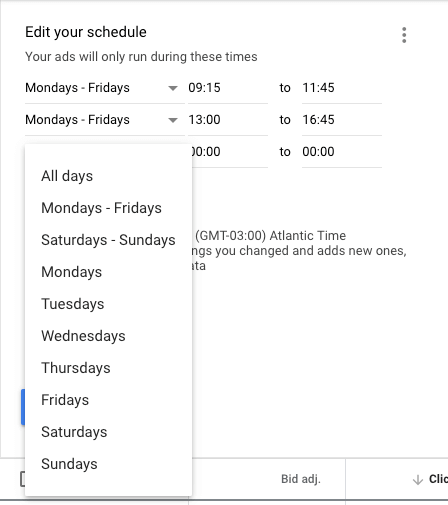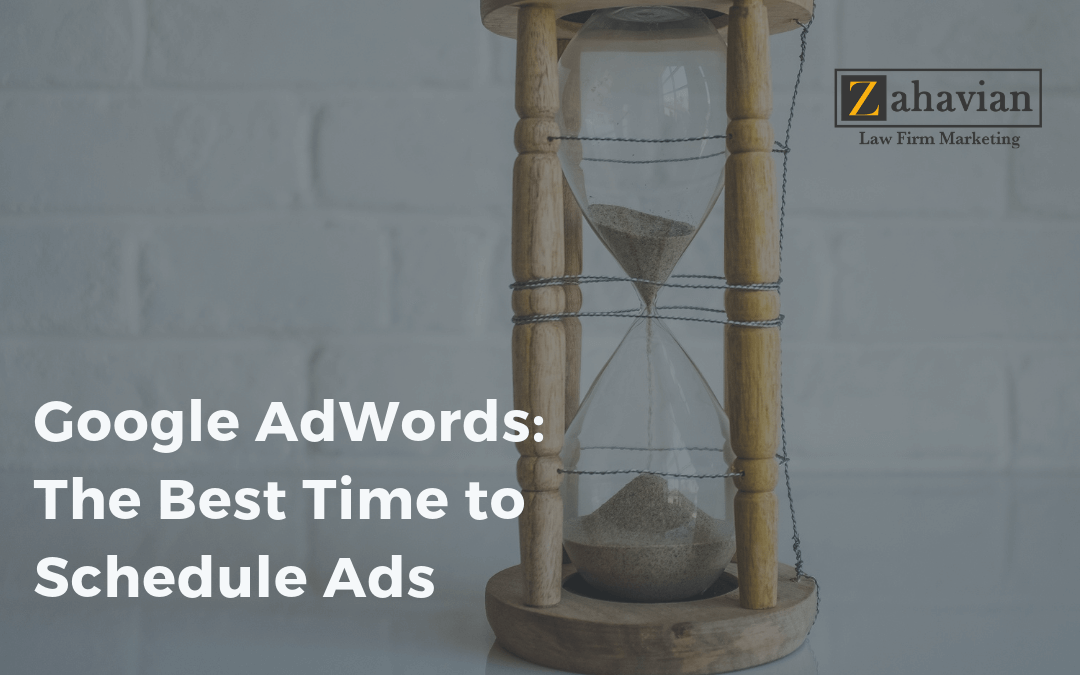When it comes to online advertising, you’re charged on a PPC basis. With that said, Google Ads can make your ads reach or at least approach a specific goal by using a bidding strategy such as Target ROAS or CPA. While this can work well for advertisers, it doesn’t fit all cases and situations. For instance, many local businesses advertise in local time zones. With that in mind, local and service-based businesses can get more out of their advertising budget by optimizing their ad delivery by time of day and day of the week. We performed a study to determine exactly what were the best hours and days to advertise – based on conversions such as contact and lead form submissions.
When is the best time and day to run Google Ads? When running the campaign 24 hours per day, 7 days per week the results showed that 7 PM was the highest converting hour at 10.8% and Tuesdays were the highest converting day at 22.5% of all lead form conversions.
That’s great if you have a small budget and can only afford to spend enough to advertise one day per week for an hour at that. However, we observed some interesting statistics that may enable you to make better decisions with your internet marketing campaigns. At the very least, you’ll have a better view of the data collection so you can run your own experiments to optimize your campaigns based on local time and weekday.
The Best Time to Schedule Google AdWords
Google AdWords can be expensive in terms of CPC (cost per click). Therefore optimizing when your potential visitors are most likely to convert can help lower your CPA (cost per acquisition) and get much more out of your campaign budget.
Conversions by Day of the Week
| Day of Week | % of Conversions | |
| 1. | Tuesday | 22.5% |
| 2. | Wednesday | 18.3% |
| 3. | Monday | 16.7% |
| 4. | Friday | 14.2% |
| 5. | Thursday | 10.8% |
| 6. | Saturday | 9.2% |
| 7. | Sunday | 8.3% |
The most popular day of the week, as mentioned earlier was Tuesdays at 22.5%. 57.5% of all lead conversions occurred in Monday, Tuesday and Wednesday. The second most popular day being Wednesday at 18.3%. The Weekend accounted for a total of 17.5%, giving the week the bulk of the conversions, summing 82.5%.
Put another way, if you were to consider whether or not to run ads on the weekend versus business days based on the data, the weekend (Saturday and Sunday) averaged 8.75% per day, whereas the business days were performing at 16.5% per day – using a simple percentage average. While the top performing day, Tuesday was more than double the lower performing business day (Thursday) at 10.8%, the lowest week day still outperforms the weekend conversions any way you cut it.
If you had an ad budget of $100 per week and spent it evenly each day of the week (7 days) that would afford you approximately $14.29 per day. However, if you were to pause your Google Ads campaign during the weekend, hence only running it during the week, you would be able to spend $20 per day instead of $14.29 on days that lead to almost twice the amount of conversions compared to the weekend (16.5% vs 8.75%).
Looking at this in terms of efficiency in terms of every dollar you spend on ads, here are two models to demonstrate the difference. The formula is simple. Take the daily ad spend and multiply it against the conversion performance (%). For this, we compare 3 possible ad spend models:
- Model 1: Ad Budget Spent evenly across all 7 days per week
- Model 2: Ad Budget Spent evenly across all business days (Mon – Fri)
- Model 3: Ad Budget Spent evenly across the top 4 performing days (Mon-Wed, Fri)
| Day of Week | % of Avg. Weekly Conversions | Model 1 Daily Ad Spend | Model 1 Daily Efficiency | Model 2 Daily Ad Spend | Model 2 Daily Efficiency | Model 3 Daily Ad Spend | Model 3 Daily Efficiency |
| Sun | 8.33% | $14.29 | 1.19 | $0.00 | 0.00 | $0.00 | 0.00 |
| Mon | 16.67% | $14.29 | 2.38 | $20.00 | 3.33 | $25.00 | 4.17 |
| Tue | 22.50% | $14.29 | 3.22 | $20.00 | 4.50 | $25.00 | 5.63 |
| Wed | 18.33% | $14.29 | 2.62 | $20.00 | 3.67 | $25.00 | 4.58 |
| Thu | 10.83% | $14.29 | 1.55 | $20.00 | 2.17 | $0.00 | 0.00 |
| Fri | 14.17% | $14.29 | 2.02 | $20.00 | 2.83 | $25.00 | 3.54 |
| Sat | 9.17% | $14.29 | 1.31 | $0.00 | 0.00 | $0.00 | 0.00 |
| Total | 100% | $100 | 14.29 | $100 | 16.50 | $100 | 17.92 |
This is a simple model, with some assumptions built in about CPC being steady across all days and times. However, Model 3 (top 4 days) performs by far the best with an efficiency score of 17.92 and Model 2 performs better than spending the budget evenly across all (7) days of the week.
Conversions by Time of Day
The conversion data for this is from the exact same set, however we’re now looking exclusively at the times of day that performed best. As mentioned earlier, the best hour of the day for lead conversions was 7PM, collecting 10.8% of leads at any given hour. What may be more interesting is that the top 3 hours were 6 to 8 PM, collecting 29.2% of the conversions.
If anything, this supports the findings of 7PM being the best hour of the day, since it’s within the top 3 performing hour window. 6, 8 and 9 were the top three individually and as a summation.
The following time frames that demonstrated significant results were 3-9PM – a six hour window – producing 55.8% and 2PM – 12AM (a ten hour window) yielded 73.3% of all leads. The worst performing hours were 7 – 11 AM, producing only 5% of the leads.
Scheduling Your Google Search Ads
The Google Ads platform is seriously robust in what is has to offer in terms of functionality. Creating a dynamic and completely customized schedule for your ads is simple. It allows advertisers to choose which days of the week and what times of day they wish to run ads.

Scheduling ads is as simple as choosing the days to apply time intervals to and setting the intervals. The ads run off of a 24-hour clock, so it’s deliberate in terms of when you’re telling your ads to run. Schedules can be changed or modified on the fly.
Why Schedule vs Running Ads Continuously?
There are many reasons to run ads. We’ve already gone over many of the reasons above, in terms of time of day and day of week where people are most likely to take action on our website. Above we were discussing data based solely lead form conversions.
However, many businesses prefer to receive phone calls for sales and intakes. Some businesses prefer collecting information on a lead form, so they can follow up with the prospective customer. Others businesses and industries prefer to have the lead call them and close them over the initial call.
When running ads, people may click on an ad and land on the website. At which point your primary objective, as an advertiser may be to get them to call your business. Therefore, the best time to run your ads are during business hours.

The image above shows us an ad schedule for Monday – Friday: 9:15AM to 4:45PM in the advertiser’s local time zone. Furthermore, there’s an hour blocked out for noon hour (that’s when the business staff take lunch, hence no one is there to answer the phones). This technique works especially well for running Google mobile call only ads.
Is it Always Better to Schedule Ads?
Scheduling ads will depend on the nature of the business. Whether it’s international or local, whether phone calls or lead forms are prioritized. If your ads are limited to daily budgets, then you could benefit from having ads restricted to specific hours and days. However, it’s strongly recommended to keep your business’ ads schedule completely open initially while you collect data to determine your optimal ad schedule.
Even the example given above, where ads are only scheduled during business hours, is to optimize phone calls without leads being sent to voicemail. The drop-off rate at voicemail could harm the profitability of the advertiser. However, this ad schedule doesn’t adhere to the conversion data for lead submissions found in this study. So limiting the ads just to business hours could also be harming the potential results.
Conclusion
While it may make sense that people are more likely to convert after they’ve finished their work for the day (at least for the normal 9-5ers) and we observed significantly less conversions on the weekends, we recommend that you run your own internal study on your ad campaigns and conversions to determine the optimal ad schedule for your business. Jumping to conclusions may lead to the wrong outcomes. All you need to run this experiment is to record the date and time of conversions. However, if you want to get the most from your data, look at recording more variables, such as:
- Landing page
- Device type (Desktop, Mobile, Tablet)
- Lead quality
- Conversion value
There are more variables that you can measure, but these are some general ones that can give you a better understanding. With this, you’ll be able to understand not only when conversions occur, but when the most valuable conversions occur and from what device.


